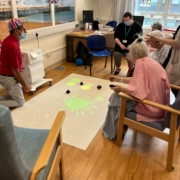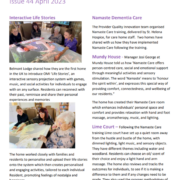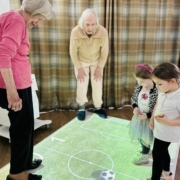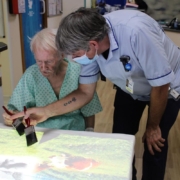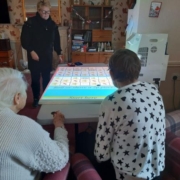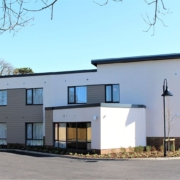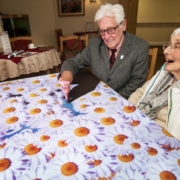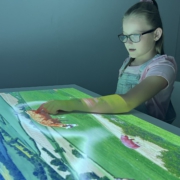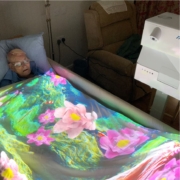OMi Life Stories Earns Recognition from Essex County Council for Improving Quality of Life in Care Homes
/in News/by Soorj GillIntergenerational Magic: Children and Seniors Connect through Play with Mobii!
/in News/by Soorj GillInteractive projector helps dementia patients in Bournemouth
/in News/by Soorj GillAN INNOVATIVE new piece of equipment at Royal Bournemouth Hospital has been praised for bringing joy to patients living with dementia.
Bournemouth Hospital recently took delivery of a new sensory projector which uses meaningful activities to encourage movement, active participation and shared enjoyment for patients.
The omiVista Mobii interactive projection system is designed for people at all stages of dementia. It helps users achieve greater socialisation and communication, physical movement and lucidity.
Katie Horswill, dementia and delirium team lead at Bournemouth, said “We arranged for a demonstration of the omiVista on one of our older persons wards and instantly saw the huge positive impact it would have on our patients and staff.
“We are currently caring for a gentleman who is living with dementia who was quite withdrawn when he first came into hospital and we needed to find a way to engage with him. We thought we would try the omiVista.
“We chose to use a picture of an unpainted, black and white fence projected onto a table. I placed one of the paint brushes in the patient’s hand and asked him if he would kindly help me paint the fence. He instantly started painting and the projected image started to fill with colour.
“It was so lovely to see and quite emotional to watch.”
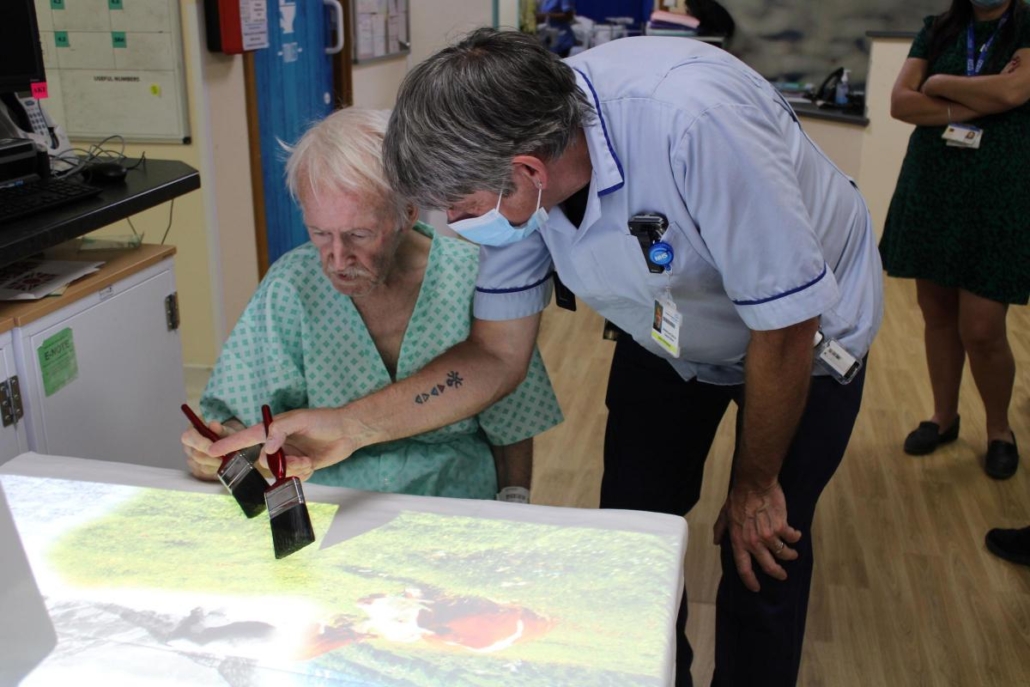
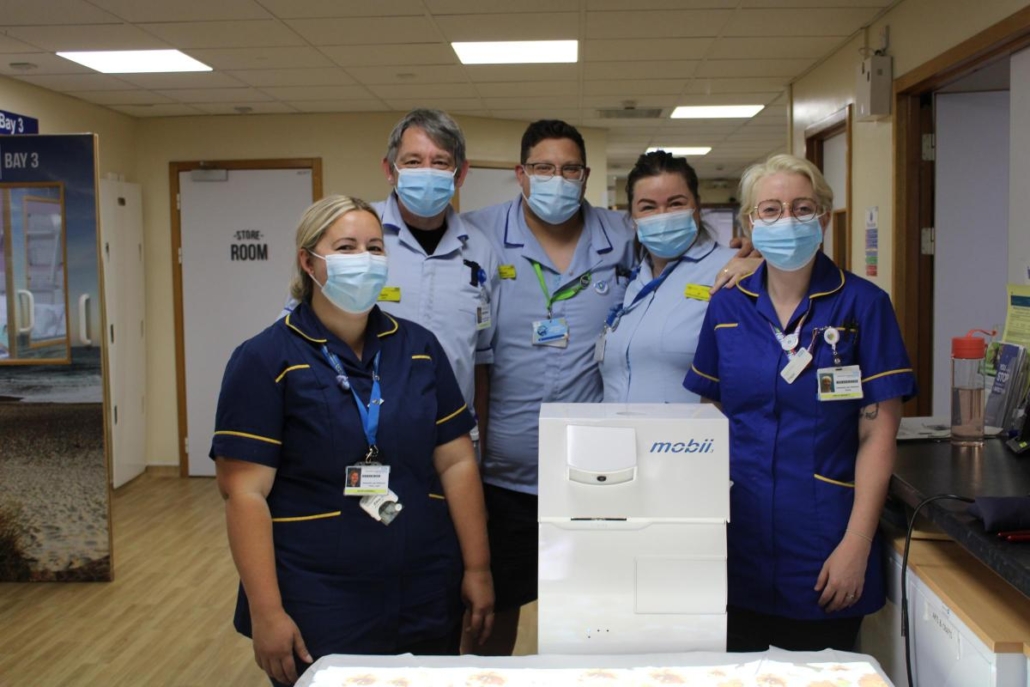
HRH The Princess of Wales – Kate Middleton – helped bring a bit of Mobii Magic to the Residents of Oxford House Care Home in Slough.
/in News/by Soorj GillElior launches interactive sensory tables into care estate
/in News/by Soorj Gill
The Mobi interactive sensory table is a portable projection system that can be used on any surface- a table, the floor or a bed. Users can engage in over 150 different activities ranging from painting flowers and walking through fish filled water to playing games such as football or shove penny.
Laura Tighe, Elior’s managing director for health, care and residential living, said: “We are always looking for innovative ways to enhance our offering for our clients and their residents and these interactive tables are a wonderful way to enrich the residents’ day and create a fun way for our team to interact with the residents in their care.”
The Mobi interactive sensory table won the National Dementia Care Outstanding Project Award in 2018 for the opportunities and benefits that it created for people at all stages of dementia.
Pete Newman, catering contracts manager at Anchor, added: “We were excited to trial these interactive sensory tables at our extra care locations. The feedback from the residents was wonderful and our care teams were delighted to see the joy and positive impact created by this innovative and engaging projection system.”
Welcoming the latest care innovations to Potters Grange
/in News/by Soorj GillHave you heard of an interactive magic board? It is a motion-activated projection system that’s enables it’s user to truly interact and get involved with a choice of activities, including games, music, reminiscence, and lots more.
The clever design and mobile ability of the interactive table has meant that we can bring the interaction to residents wherever suits them best. The machine can be projected onto a bedsheet or side table to give complete comfortability to individuals, for some this really has made a huge impact to their day to day lives. It has meant that simple things such as playing games and participating in quizzes with other residents are just that; simple.
Using the board can trigger cherished memories opening up opportunity to share personal stories, it can improve upper body movement and coordination, and enhance mental wellbeing. As well as all these benefits, we can see clear and undeniable enjoyment and laughter from all of our residents.
Interactive sensory activities have had proven benefits for people living with dementia, its opens up doors for learning, socialisation, exercise and can be a truly inclusive and calming activity for them. Carol Pintus, Activities Coordinator at Potters Grange tells us ‘The magic interactive table has become a firm favourite amongst everyone at Potters Grange and opens up ample opportunity for our residents, staff and family members to start conversations and have fun.’
‘Magic tables’ bring joy and laughter to care homes
/in Case Study, News/by Soorj Gill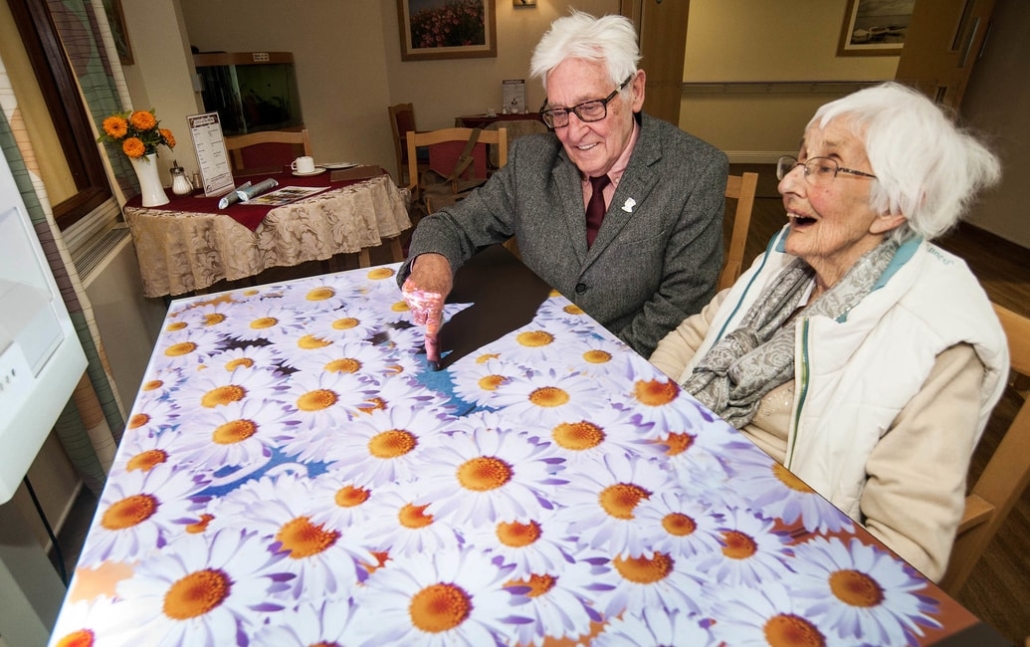
Squashing tomatoes, splashing in rock pools and popping bubbles are just some of the activities residents living in MHA care homes are starting to enjoy thanks to new technology which is helping spark conversations and stimulate activity.
Homes are investing in interactive, motion-activated sensory projection systems which support residents living with dementia – and the effect on residents, their families and staff has been amazing.
With the goal of stimulating, engaging and relaxing the mind, the projection technology, which is manufactured in the UK and nicknamed ‘magic tables’, comes equipped with quizzes, music and themes that have been designed to prompt conversations, spark nostalgia and maintain memory. Its use of therapeutic scenes and sounds which derive from nature have been known to instantly promote feelings of calm for residents living with dementia.
Through this motion-activated technology, residents can reach out to crack an egg and make a cake, grow a flower simply by touching it, and even dip their toes in the water as the tide rolls in – all without leaving the sense of security that their own room provides. This is made possible by the equipment’s portable and height-adjustable properties which are able to project coloured streams of light onto any table, bed or floor.
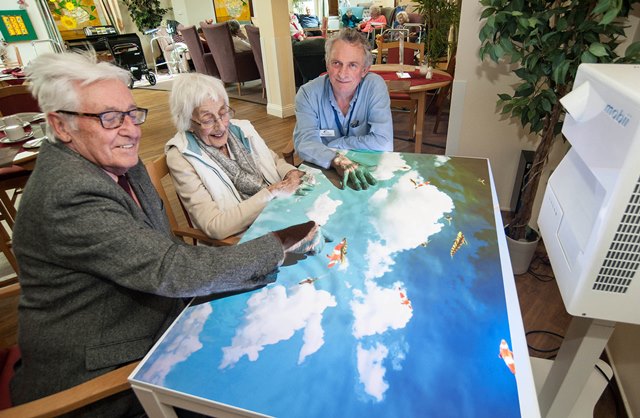
For some residents living with dementia, their ability to speak or socialise with others can become a struggle. But with this new activity that all generations can enjoy, including children and their grandparents alike, staff at MHA care homes have been able work with residents like never before.
Langholme care home in Falmouth is one of the first homes to have the equipment and one of the few care homes in the South West to offer this technology.
Maria Brown, Home Manager, said: “I first noticed the effect one of these projection games could have when a company came to demonstrate it at our Summer Fair last year, after seeing one of our dementia residents, who was visibly distressed at the number of people around her, immediately become immersed in the interactive game.
“After that, I remember telling our team that we simply had to have one, whatever it takes.”
Administration Manager Kate Bateson adds: “Here at MHA Langholme, we understand the benefits that social interaction has on the day-to-day lives of our residents. The effect this technology has isn’t like anything I have ever seen before – its ability to soothe and engage residents is enough to bring a tear to anyone’s eye.”
Another home to be among the first to use the tables is Claybourne in Stoke on Trent. Kerry Rafferty, Home Manager, said: “I observed the residents who were using the table to be in total wellbeing. There were residents who usually have minimal ability to engage in activities for long periods totally engrossed in the table’s fun.”
Lauren Till, Activity Coordinator, added: “The ‘magic table’ enhances the live of residents on a daily basis by enabling them to use their sensory skills to interact through touch, sound and sight. Residents are engaged for a longer period of time that helps reduce their anxiety and bring them into well-being.”
Some of our other homes with the magic table include The Fairways at Chippenham, The Meadow in London, and Lower Johnshill at Auchlochan Garden Village.
MHA’s Operation Manager for Dementia David Moore said: “The tables provide endless possibilities for residents, their families and staff to enjoy activities together. The technology is portable, meaning everyone within the home can enjoy it.”
Click the link below to view the original case study posted by MHA.
iSensoryCIC – Wandsworth, London.
/in News/by Soorj GilliSensoryCIC provide a safe and professional learning centre for children with ADHD or Autism. They offer interactive workshops, learning support and family support across Wandsworth, London.
Grosvenor House, OMi Mobii Magic Surface
/in News/by Soorj GillMotion-activated projections, endorsed by National Dementia Care
Grosvenor House Care Home are continuously on the lookout for new ways of providing different experiences for our residents and visitors. We invest in state of the art technology and the best facilities, which combined with our personal and dedicated approach contribute to being the number one care home in the Gainsborough area.
We have recently invested in an Omi Mobii Magic Surface interactive projector system which is particularly suited to our residents living with dementia.
The Omi equipment is a motion-activated projection system that projects quickly on to tables, beds and floors. Our residents have been able to use this equipment as part of group activities as well as during 1-on-1 emotional and calming sessions while in bed.
Benefits to our residents
The Omi projector allows our residents to take part in meaningful activities together. They can push “items” around on the interactive table, or simply watch the amazing scenes right before their eyes.
The Omi projector has been proven to help reduce stress, improve emotional stability and aid with mobility and social interactions.
Click on the below link to read more on the article posted by Grosvenor Care.

